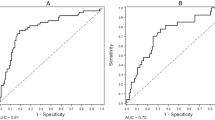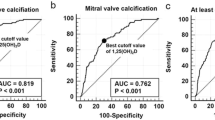Abstract
Matrix Gla protein (MGP), a natural inhibitor of calcification, strongly correlates with the extent of coronary calcification. Vitamin K is the essential cofactor for the activation of MGP. The nonphosphorylated-uncarboxylated isoform of MGP (dp-ucMGP) reflects the status of this vitamin. We investigated whether there is an association between dp-ucMGP and stiffness of elastic and muscular-type large arteries in a random sample from the general population. In a cross-sectional design, we analyzed 1087 subjects from the Czech post-MONICA study. Aortic and femoro-popliteal pulse wave velocities (PWVs) were measured using a Sphygmocor device. Dp-ucMGP concentrations were assessed in freshly frozen samples by enzyme-linked immunosorbent assay methods using the InaKtif MGP iSYS pre-commercial kit developed by IDS and VitaK. Aortic PWV significantly (P<0.0001) increased across the dp-ucMGP quartiles. After adjustment for all potential confounders, aortic PWV independently correlated with dp-ucMGP (with beta coefficient (s.d.) 11.61 (5.38) and P-value=0.031). In a categorized manner, subjects in the top quartile of dp-ucMGP (⩾ 671 pmol l−1) had a higher risk of elevated aortic PWV, with corresponding adjusted odds ratio (95% confidence interval) 1.73 (1.17–2.5). In contrast, no relation between dp-ucMGP and femoro-popliteal PWV was found. In conclusion, increased dp-ucMGP, which is a circulating biomarker of vitamin K status and vascular calcification, is independently associated with aortic stiffness, but not with stiffness of distal muscular-type arteries.
This is a preview of subscription content, access via your institution
Access options
Subscribe to this journal
Receive 12 digital issues and online access to articles
$119.00 per year
only $9.92 per issue
Buy this article
- Purchase on Springer Link
- Instant access to full article PDF
Prices may be subject to local taxes which are calculated during checkout


Similar content being viewed by others
References
O’Rourke MF, Mancia G . Arterial stiffness. J Hypertens 1999; 17: 1–4.
Laurent S, Cockcroft J, Van Bortel L, Boutouyrie P, Giannattasio C, Hayoz D et al. European network for non-invasive investigation of large arteries. Expert consensus document on arterial stiffness: methodological issues and clinical applications. Eur Heart J 2006; 27: 2588–2605.
Dao HH, Essalihi R, Bouvet C, Moreau P . Evolution and modulation of age-related medial elastocalcinosis: impact on large artery stiffness and isolated systolic hypertension. Cardiovasc Res 2005; 66: 307–317.
Fornieri C, Quaglino D Jr, Mori G . Role of the extracellular matrix in age-related modifications of the rat aorta. Ultrastructural, morphometric, and enzymatic evaluations. Arterioscler Thromb 1992; 12: 1008–1016.
Cattell MA, Anderson JC, Hasleton PS . Age-related changes in amounts and concentrations of collagen and elastin in normotensive human thoracic aorta. Clin Chim Acta 1996; 245: 73–84.
Bruel A, Oxlund H . Changes in biomechanical properties, composition of collagen and elastin, and advanced glycation endproducts of the rat aorta in relation to age. Atherosclerosis 1996; 127: 155–165.
Keeley FW, Partridge SM . Amino acid composition and calcification of human aortic elastin. Atherosclerosis 1974; 19: 287–296.
Demer LL, Tintut Y . Vascular calcification: pathobiology of a multifaceted disease. Circulation 2008; 117: 2938–2948.
Schurgers LJ, Spronk HM, Soute BA, Schiffers PM, DeMey JG, Vermeer C . Regression of warfarin-induced medial elastocalcinosis by high intake of vitamin K in rats. Blood 2007; 109: 2823–2831.
Braam LA, Hoeks AP, Brouns F, Hamulyak K, Gerichhausen MJ, Vermeer C . Beneficial effects of vitamins D and K on the elastic properties of the vessel wall in postmenopausal women: a follow-up study. Thromb Haemost 2004; 91: 373–380.
Shea MK, O'Donnell CJ, Hoffmann U, Dallal GE, Dawson-Hughes B, Ordovas JM et al. Vitamin K supplementation and progression of coronary artery calcium in older men and women. Am J Clin Nutr 2009; 89: 1799–1807.
Shanahan CM, Proudfoot D, Farzaneh-Far A, Weissberg PL . The role of Gla proteins in vascular calcification. Crit Rev Eukaryot Gene Expr 1998; 8: 357–375.
Price PA, Urist MR, Otawara Y . Matrix Gla protein, a new gamma-carboxyglutamic acid-containing protein which is associated with the organic matrix of bone. Biochem Biophys Res Commun 1983; 117: 765–771.
Schurgers LJ, Cranenburg ECM, Vermeer C . Matrix Gla-protein: the calcification inhibitor in need of vitamin K. Thromb Haemost 2008; 100: 593–603.
Cranenburg ECM, Koos R, Schurgers LJ, Magdeleyns EJ, Schoonbrood TH, Landewé RB et al. Characterisation and potential diagnostic value of circulating matrix Gla protein (MGP) species. Thromb Haemost 2010; 104: 811–822.
Schurgers LJ, Spronk HM, Skepper JN, Hackeng TM, Shanahan CM, Vermeer C et al. Post-translational modifications regulate matrix Gla protein function: importance for inhibition of vascular smooth muscle cell calcification. J Thromb Haemost 2007; 5: 2503–2511.
van den Heuvel EG, van Schoor NM, Lips P, Magdeleyns EJ, Deeg DJ, Vermeer C et al. Circulating uncarboxylated matrix Gla protein, a marker of vitamin K status, as a risk factor of cardiovascular disease. Maturitas 2014; 77: 137–141.
Dalmeijer GW, van der Schouw YT, Vermeer C, Magdeleyns EJ, Schurgers LJ, Beulens JW . Circulating matrix Gla protein is associated with coronary artery calcification and vitamin K status in healthy women. J Nutr Biochem 2013; 24: 624–628.
Schurgers LJ, Barreto DV, Barreto FC, Liabeuf S, Renard C, Magdeleyns EJ et al. The circulating inactive form of matrix gla protein is a surrogate marker for vascular calcification in chronic kidney disease: a preliminary report. Clin J Am Soc Nephrol 2010; 5: 568–575.
Mayer O Jr, Seidlerová J, Bruthans J, Filipovský J, Timoracká K, Vaněk J et al. Desphospho-uncarboxylated matrix Gla-protein is associated with mortality risk in patients with chronic stable vascular disease. Atherosclerosis 2014; 235: 162–168.
Cífková R, Skodová Z, Bruthans J, Adámková V, Jozífová M, Galovcová M et al. Longitudinal trends in major cardiovascular risk factors in the Czech population between 1985 and 2007/8. Czech MONICA and Czech post-MONICA. Atherosclerosis 2010; 211: 676–681.
Laurent S, Boutouyrie P, Asmar R, Gautier I, Laloux B, Guize L et al. A Aortic stiffness is an independent predictor of all-cause and cardiovascular mortality in hypertensive patients. Hypertension 2001; 37: 1236–1241.
Vlachopoulos C, Aznaouridis K, Stefanadis C . Prediction of cardiovascular events and all-cause mortality with arterial stiffness: a systematic review and meta-analysis. J Am Coll Cardiol 2010; 55: 1318–1327.
Williams B, Lacy PS, Thom SM, Cruickshank K, Stanton A, Collier D et al. Differential impact of blood pressure-lowering drugs on central aortic pressure and clinical outcomes: principal results of the Conduit Artery Function Evaluation (CAFE) study. Circulation 2006; 113: 1213–1225.
Luo G, Ducy P, McKee MD, Pinero GJ, Loyer E, Behringer RR et al. Spontaneous calcification of arteries and cartilage in mice lacking matrix GLA protein. Nature 1997; 386: 78–81.
Krüger T, Oelenberg S, Kaesler N, Schurgers LJ, van de Sandt AM, Boor P et al. Warfarin induces cardiovascular damage in mice. Arterioscler Thromb Vasc Biol 2013; 33: 2618–2624.
Wang Y, Chen J, Zhang Y, Yu W, Zhang C, Gong L et al. Common genetic variants of MGP are associated with calcification on the arterial wall but not with calcification present in the atherosclerotic plaques. Circ Cardiovasc Genet 2013; 6: 271–278.
Tuñón-Le Poultel D, Cannata-Andía JB, Román-García P, Díaz-López JB, Coto E, Gómez C et al. Association of matrix Gla protein gene functional polymorphisms with loss of bone mineral density and progression of aortic calcification. Osteoporos Int 2014; 25: 1237–1246.
Yoshikawa K, Abe H, Tominaga T, Nakamura M, Kishi S, Matsuura M et al. Polymorphism in the human matrix Gla protein gene is associated with the progression of vascular calcification in maintenance hemodialysis patients. Clin Exp Nephrol 2013; 17: 882–889.
Beulens JW, Bots ML, Atsma F, Bartelink ML, Prokop M, Geleijnse JM et al. High dietary menaquinone intake is associated with reduced coronary calcification. Atherosclerosis 2009; 203: 489–493.
Jie KS, Bots ML, Vermeer C, Witteman JC, Grobbee DE . Vitamin K intake and osteocalcin levels in women with and without aortic atherosclerosis: a population-based study. Atherosclerosis 1995; 116: 117–123.
Villines TC, Hatzigeorgiou C, Feuerstein IM, O'Malley PG, Taylor AJ . Vitamin K1 intake and coronary calcification. Coron Artery Dis 2005; 16: 199–203.
Geleijnse JM, Vermeer C, Grobbee DE, Schurgers LJ, Knapen MH, van der Meer IM et al. Dietary intake of menaquinone is associated with a reduced risk of coronary heart disease: the Rotterdam Study. J Nutr 2004; 134: 3100–3105.
Gast GC, de Roos NM, Sluijs I, Bots ML, Beulens JW, Geleijnse JM et al. A high menaquinone intake reduces the incidence of coronary heart disease. Nutr Metab Cardiovasc Dis 2009; 19: 504–510.
Knapen MH, Braam LA, Drummen NE, Bekers O, Hoeks AP, Vermeer C . Menaquinone-7 supplementation improves arterial stiffness in healthy postmenopausal women: double-blind randomised clinical trial. Thromb Haemost 2015; 113: 1135–1144.
Mitchell GF, Parise H, Benjamin EJ, Larson MG, Keyes MJ, Vita JA et al. Changes in arterial stiffness and wave reflection with advancing age in healthy men and women: the Framingham Heart Study. Hypertension 2004; 43: 1239–1245.
Acknowledgements
The clinical part of the project was supported by the Internal Grant Agency of Czech Ministry of Health (NT13186) and by the Charles University Research Fund (project number P36). We are grateful to IDS Plc., providing free of charge, newly developed kits for estimation of dp-ucMGP. We would like to acknowledge the hard work of all investigators in the Czech Republic who participated in the post-MONICA project, and last but not least all laboratory technicians, realizing extent laboratory assessments for the present study.
Author information
Authors and Affiliations
Corresponding author
Ethics declarations
Competing interests
The authors declare no conflict of interest
Rights and permissions
About this article
Cite this article
Mayer Jr, O., Seidlerová, J., Wohlfahrt, P. et al. Desphospho-uncarboxylated matrix Gla protein is associated with increased aortic stiffness in a general population. J Hum Hypertens 30, 418–423 (2016). https://doi.org/10.1038/jhh.2015.55
Received:
Revised:
Accepted:
Published:
Issue Date:
DOI: https://doi.org/10.1038/jhh.2015.55
This article is cited by
-
Increased Cardiovascular Risk in Young Patients with CKD and the Role of Lipid-Lowering Therapy
Current Atherosclerosis Reports (2024)
-
Vitamins as regulators of calcium-containing kidney stones — new perspectives on the role of the gut microbiome
Nature Reviews Urology (2023)
-
Inactive matrix Gla protein in relation to diabetic retinopathy in type 2 diabetes
Journal of Diabetes & Metabolic Disorders (2023)
-
Switching from Warfarin to rivaroxaban induces sufficiency of vitamin K and reduction of arterial stiffness in patients with atrial fibrillation
Heart and Vessels (2020)
-
Plasma dephosphorylated-uncarboxylated Matrix Gla-Protein (dp-ucMGP): reference intervals in Caucasian adults and diabetic kidney disease biomarker potential
Scientific Reports (2019)



